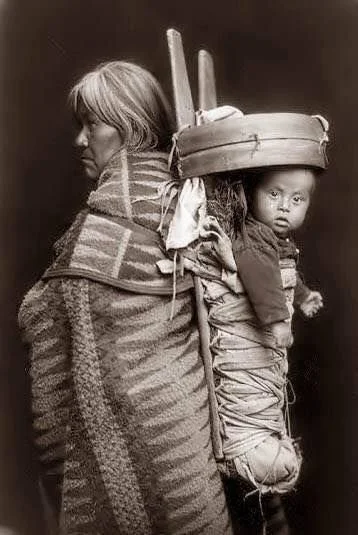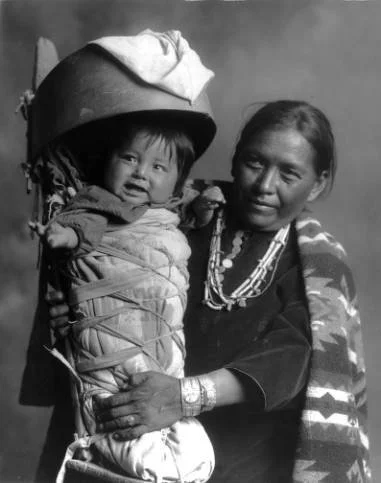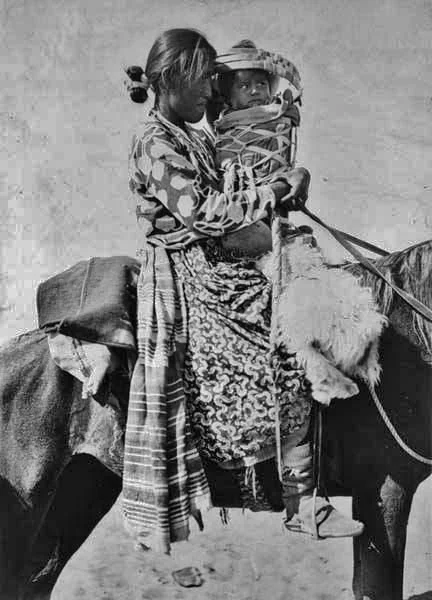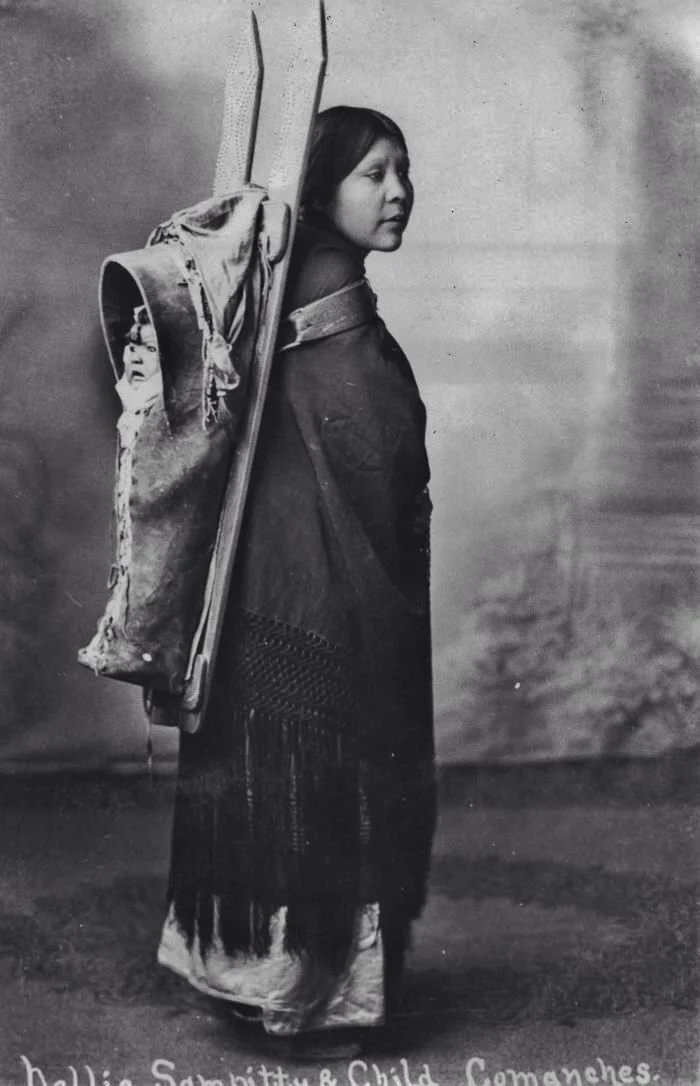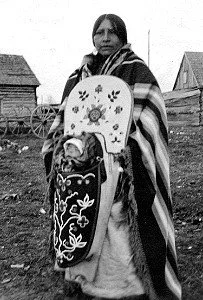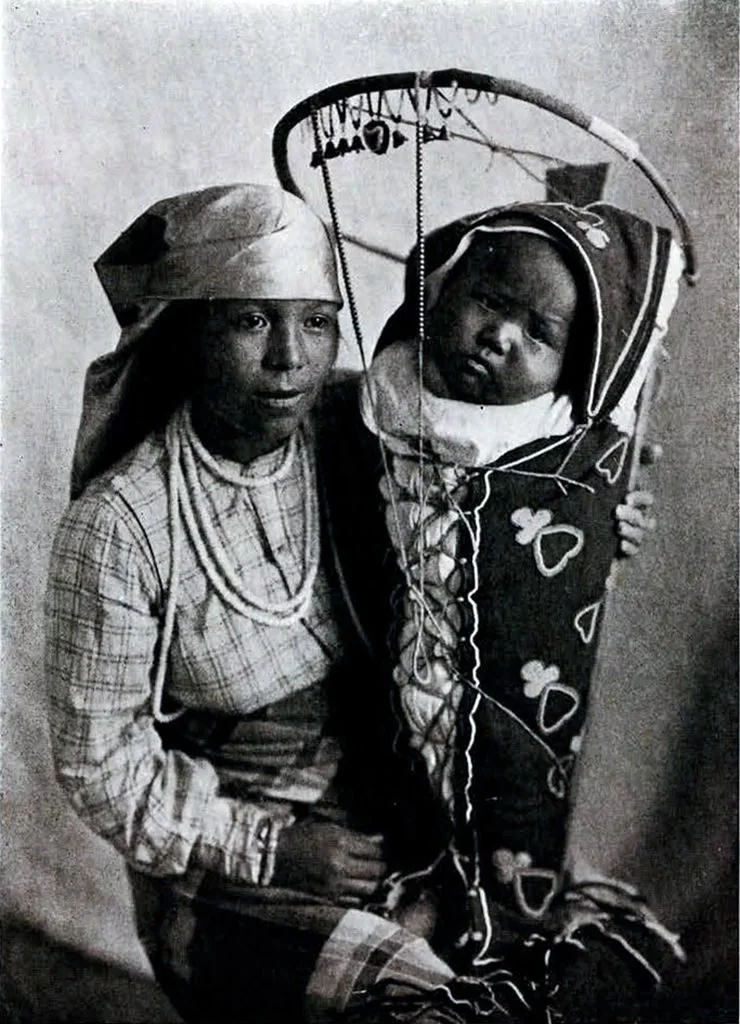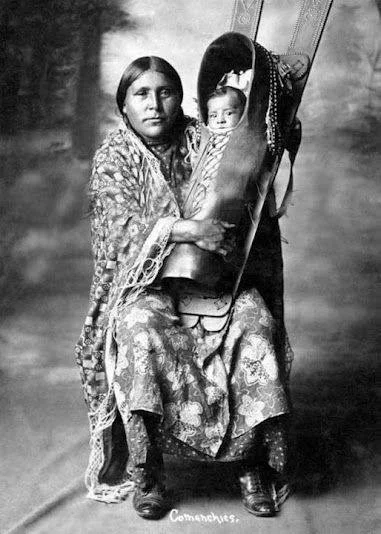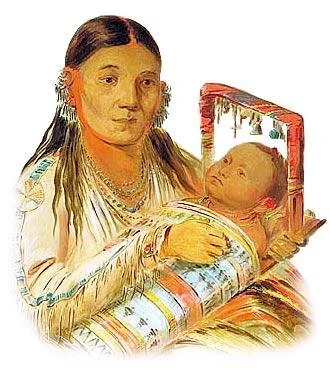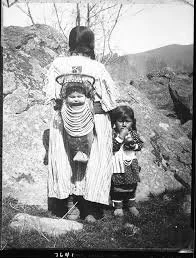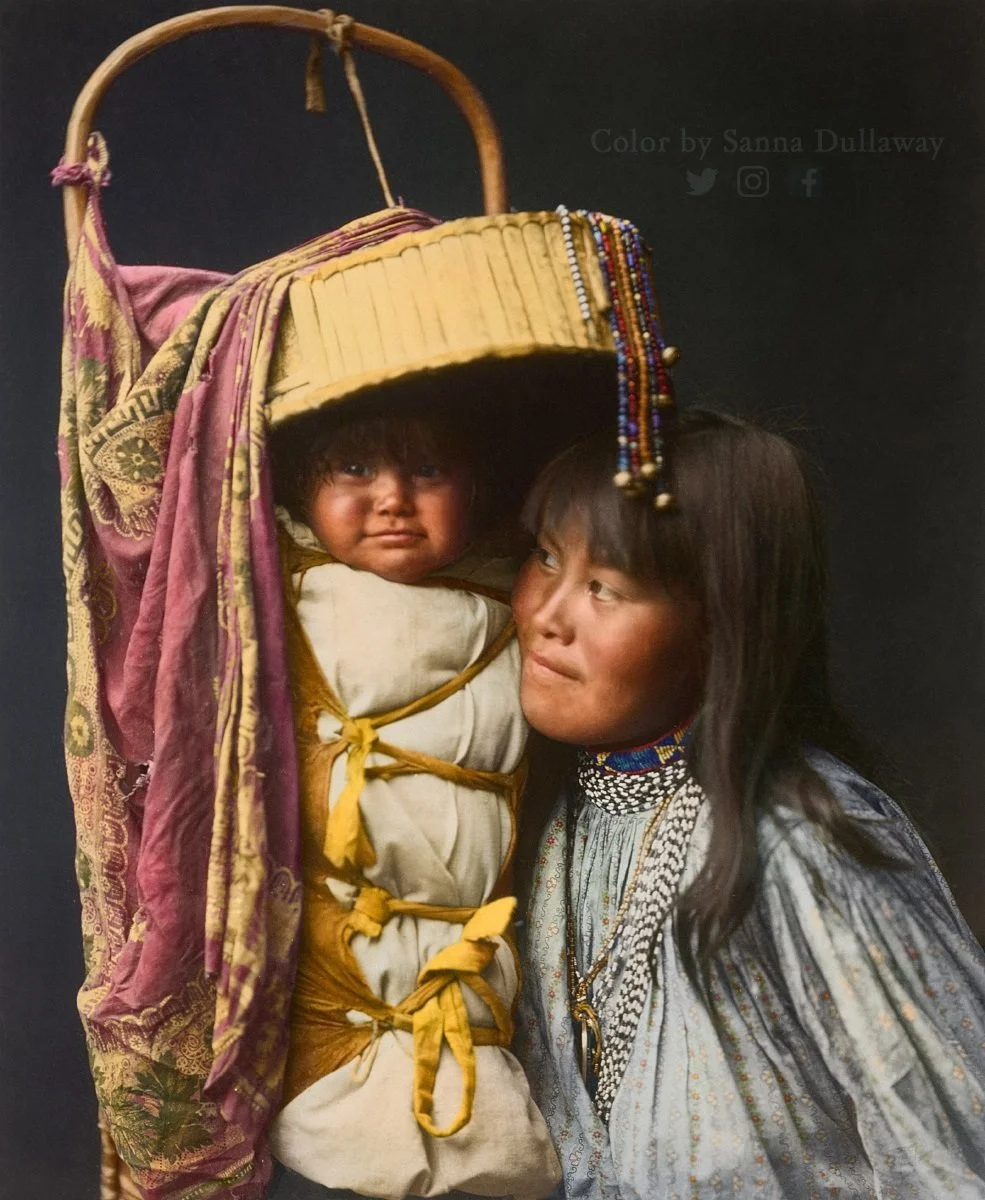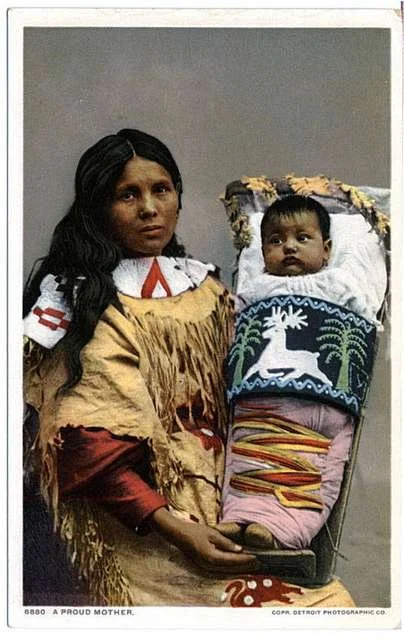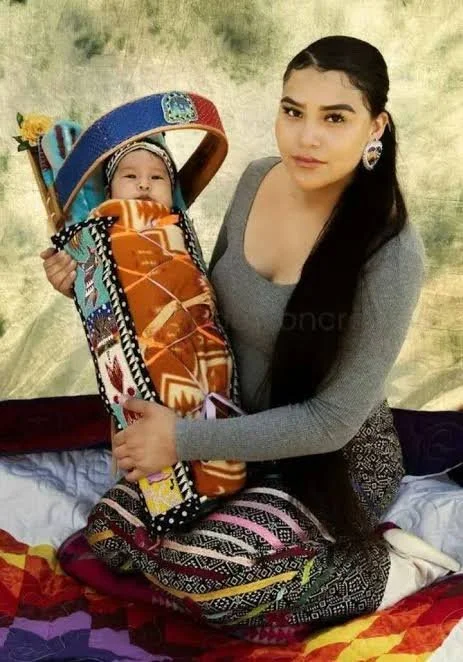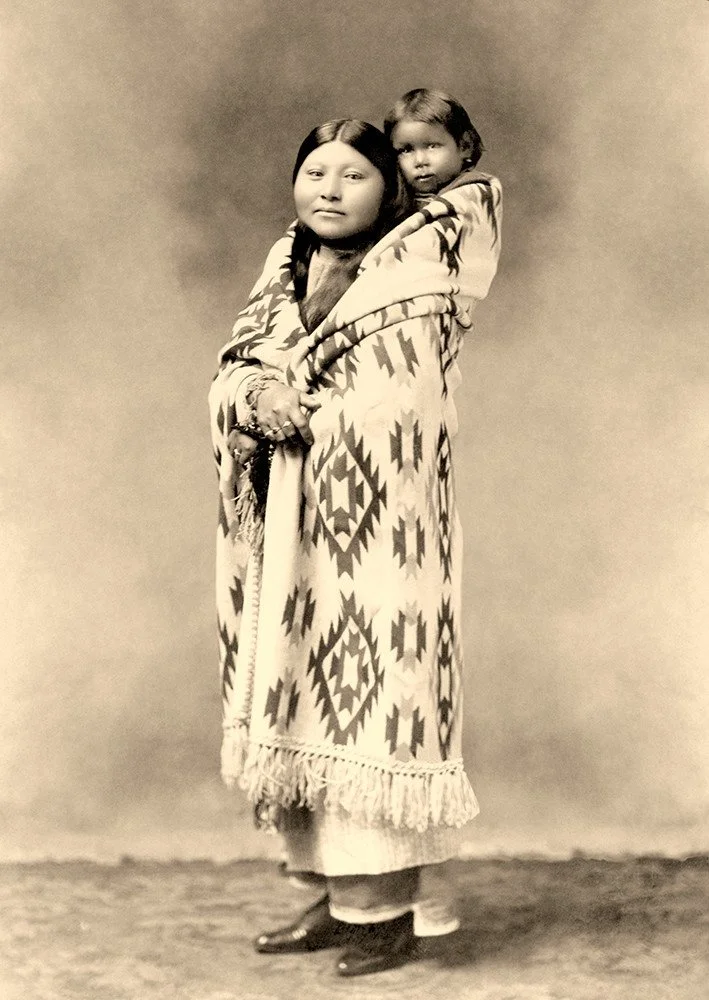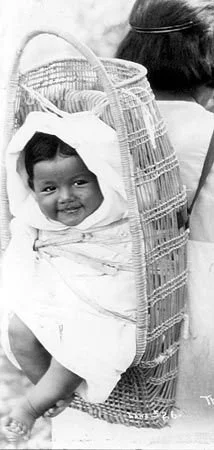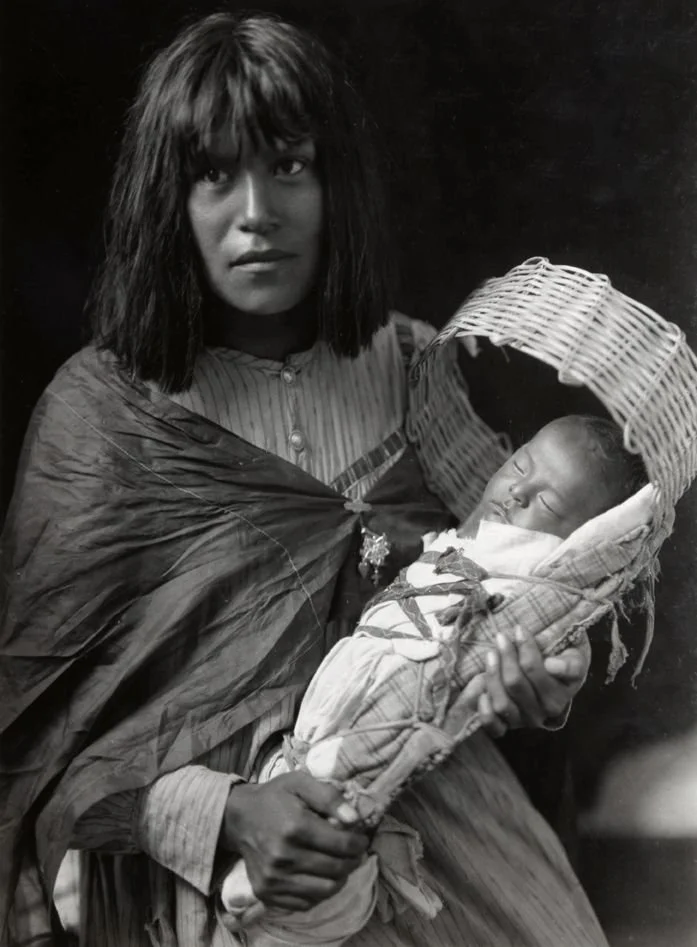North America: Cradleboards, Parkas, and Prairie Songs
We acknowledge that these images depict ancestors and cultural practices of diverse Indigenous peoples of North America. They are shared here with deep respect and gratitude, honoring the strength, artistry, and enduring love of Indigenous families and communities. We recognize that each image carries the spirit of the people and lands it represents, and we welcome guidance and corrections from community members at any time.
Across North America, countless First Nations and Native American communities have carried their babies in carefully crafted cradleboards — each one an expression of place, family, and spirit. While styles and materials vary greatly, all share a common purpose: keeping the baby close, safe, and included in community life from the very beginning.
Navajo (Diné)
Among the Navajo, cradleboards (called ts'aa' in Navajo) are constructed with meticulous care, often using juniper or willow wood to create a strong, breathable frame. A distinctive curved arch, known as the "rainbow," rises above the baby’s head, symbolizing protection and connection to the sacred natural world. Babies are wrapped snugly inside, with soft linings of sheepskin, woven cloth, or moss, then bound securely with lacing. The cradleboard allows mothers to carry their babies on their backs, lean them against a tree or wall, or keep them close during ceremonies and daily tasks. Each board is a living prayer for the child’s well-being, resilience, and connection to their people and land.
In this powerful portrait, a Diné (Navajo) mother carries her baby secured in a traditional cradleboard. The carefully laced bindings, wooden backboard, and arched sunshade — often called the “rainbow” — reflect a deep cultural practice of keeping babies safe, protected, and close to family life.
The mother is wrapped in a woven blanket, highlighting the rich textile traditions of her people and the importance of warmth and protection in the high desert environment.
For Diné families, the cradleboard is more than a practical tool: it represents prayers for the child’s health, growth, and future connection to community and land. Babies carried this way are held securely yet can still observe and learn from the world around them — a vital part of being included in daily life and ceremonies from the very start.
This image beautifully captures both strength and tenderness, reminding us of the enduring legacy of Indigenous mothering and the vital role of ancestral practices today.
This beautiful portrait features a Navajo (Diné) mother proudly holding her baby in a traditional cradleboard.
The Navajo cradleboard is carefully constructed to keep the baby secure, supported, and connected to family life even while the mother works. It often includes a wooden frame and softly padded wrappings, with a curved bow above the baby's head for protection.
The mother's jewelry and patterned blanket highlight her cultural identity and artistry, while her expression conveys warmth and strength.
This image captures a timeless moment of care and tradition — a living symbol of Diné family bonds, resilience, and the gentle art of carrying forward ancestral practices.
Apache
Apache cradleboards are known for their striking sunshades — large, sweeping curves that protect babies from the desert sun and harsh weather. Constructed from flexible willow or other local woods, these boards are lined with soft materials and often decorated with beautiful beadwork, fringe, and painted designs. The bold fringe and beading not only add beauty but also serve to amuse and comfort the baby as they move. Apache mothers skillfully wrap their babies in soft cloth or buckskin, then tie them securely to the cradleboard, making it possible to ride horseback, work, or move swiftly while keeping the baby safe and close.
Make it stand out
White Mountain Apache woman with infant in cradleboard
This striking historical portrait shows a young White Mountain Apache woman proudly holding an infant secured in a beautifully crafted cradleboard. Among the Apache, cradleboards were more than a practical way to carry babies; they represented deep cultural knowledge, careful craftsmanship, and the strength of community care. The cradleboard provided security and comfort for the baby, while allowing the mother to carry on daily work and move freely.
Photographed in the late 19th or early 20th century, this image is part of the National Anthropological Archives, Smithsonian Institution collection.
Sioux and Plains tribes
Across the Plains, cradleboards are masterpieces of beadwork and quillwork, blending artistry with spiritual meaning. The wooden backboard provides a sturdy base, while elaborate beaded covers depict stars, animals, floral motifs, and tribal symbols, each telling stories of ancestry and protection. Plains mothers often incorporate trade cloth and ribbons into the design, reflecting centuries of exchange and adaptation. Babies are swaddled warmly and laced in, allowing mothers to carry them on their backs during travel, or secure them upright near campfires and community gatherings. Each cradleboard is more than a carrier — it is a gift of identity and belonging.
This striking photograph shows a Plains mother riding on horseback while holding her baby secured in a beautifully crafted cradleboard. The cradleboard is laced snugly, ensuring the baby is safe and supported even while traveling.
For many Plains tribes — including the Lakota, Dakota, Nakota, Cheyenne, and others — horses became central to daily life after their introduction. Mothers carried their children on horseback across great distances, continuing to include them in every part of community life and work. Cradleboards not only kept babies safe but also allowed them to observe the world around them, learning from a young age.
The woman’s layered garments and patterned fabrics speak to the creativity and resilience of Plains women, who adapted to their environment with skill and care. This photo beautifully captures the strength and enduring connection between mother and child, embodying the spirit of mobility, community, and deep familial love so essential to Plains cultures.
This evocative portrait features a Ponca mother known as Cries For Ribs, holding her baby cradled in a traditional, beautifully adorned cradleboard. The baby sleeps peacefully, wrapped in layers of soft cloth and covered with a richly patterned blanket, a testament to both love and meticulous care.
The Ponca people, part of the Dhegiha branch of the Siouan language family, traditionally lived along the Niobrara River in what is now Nebraska before their forced removal to Indian Territory (present-day Oklahoma). Like other Plains tribes, Ponca cradleboards were often carefully crafted with beadwork, quillwork, and symbolic designs, each element offering blessings and protection for the child.
This image captures a quiet, intimate moment — a mother’s strength and unwavering love woven into every stitch and fold. It stands as a powerful reminder of the resilience and continuity of Ponca families and the deep cultural significance of carrying and caring for babies within community traditions.
Comanche mother Nellie Sampitty stands in quiet strength, her child carried on her back in a carefully crafted cradleboard. The tall, protective hood arches over the baby’s head, sheltering them from sun and wind.
Among the Comanche and other Plains tribes, cradleboards are more than practical tools — they are an extension of love, artistry, and cultural identity. The strong wooden backboard and soft buckskin wrappings keep the baby secure and comfortable, while leaving the mother’s hands free to work, ride, or move swiftly across the land.
Passed from generation to generation, each cradleboard carries the family’s prayers for the child’s health, safety, and belonging. This portrait of Nellie and her baby captures not only a moment in time but a deep, living connection to tradition and place.
Wrapped in a thick blanket against the prairie winds, this Plains Cree (Nehiyawak) mother stands proudly with her baby nestled in a beautifully beaded cradleboard. The intricate floral beadwork, so central to Cree artistry, blooms across the cradle like a living garden — each flower a prayer for health, strength, and protection.
The high, rounded headboard serves as both a support and a symbolic shield, connecting the baby to the spirits of the land and ancestors. Carried close to the mother's heart, the baby is gently introduced to the rhythms of community life, witnessing the world from a place of warmth and safety.
In every stitch and curve, this cradleboard tells a story of love, belonging, and cultural resilience — a quiet yet powerful testament to generations of mothers carrying forward the wisdom of their people.
Among the Apsáalooke (Crow) people of the Plains, cradleboards are cherished works of art and acts of love, carefully crafted to protect and honor each new life. Crow cradleboards often feature exquisitely detailed beadwork, elk tooth decorations, and bold geometric designs that speak to family lineage, prayers for protection, and the deep connection to the land and spirit world.
Mothers and grandmothers swaddle their babies snugly in soft buckskin or cloth, then lace them securely into the cradleboard. A curved hood or sunshade, beautifully adorned, shields the baby’s face while allowing them to observe and feel part of community life from their earliest days. Babies are carried on their mothers’ backs or propped nearby while daily tasks, ceremonies, and travels continue around them.
Each cradleboard is more than a practical tool — it is a living expression of identity, kinship, and devotion. In these lovingly beaded and decorated carriers, Crow babies are held close to the heartbeat of their people, wrapped in stories, beauty, and belonging.
This evocative photograph shows a Dakota (Sioux) mother with her baby held safely in a beautifully decorated cradleboard.
The beaded and appliqué designs on the cradleboard reflect Dakota artistry and symbolism, with protective and meaningful patterns passed down through generations. The arched frame above the baby’s head provides shade and protection, a feature common among Plains cradleboards.
The mother’s attire — a checked blouse, layered skirt, and long strands of beads — merges traditional and more contemporary clothing styles of the period, reflecting a moment of cultural continuity and adaptation.
This image embodies the strength, resilience, and profound love of Dakota mothers, as well as the community’s commitment to nurturing children within a strong cultural framework.
This timeless photograph captures the quiet strength and tenderness of a Comanche mother, holding her baby securely in a beautifully crafted cradleboard. For the Comanche, cradleboards were ingenious, multi-purpose creations designed to keep babies safe while allowing mothers the freedom to work and move through their daily tasks.
The day cradle, often carried on the mother’s back or propped nearby, was made from carefully selected soft buckskin, laced over a sturdy backboard. The baby rested snugly inside, cocooned in a protective, breathable space. At night, a special cradle lined with buffalo hide — chosen from young animals, with the fur left on the inside for warmth — offered comfort and security.
Each cradleboard was more than a practical tool; it was an extension of love and care, beautifully decorated with pierced edging, rawhide loops, and sometimes intricate beadwork. It held not just a child, but also prayers for their safety, growth, and future.
Here, the mother’s gentle gaze and the baby’s bright eyes speak of deep connection and resilience — a living tradition, carried forward through each generation.
Northeastern tribes (Mohawk, Haudenosaunee/Iroquois)
In the Northeast, cradleboards feature beautifully bent wooden hoods or curved frames, offering shelter and comfort. These hoods are often adorned with intricate floral beadwork, reflecting the importance of nature and growth in Haudenosaunee worldviews. Soft linings of moss or fur keep the baby warm, while lacing ensures they are secure and close to their caregiver. Babies in these communities remain active participants in daily village life, observing and learning from the world around them from the safety of their cradleboard.
This artwork depicts a Haudenosaunee (Iroquois) mother holding her baby in a beautifully decorated cradleboard. The softly padded board, adorned with colorful beadwork and protective charms, shows the deep care and love woven into every part of Haudenosaunee life.
In these nations, cradleboards often include bent wooden hoods and beadwork patterns inspired by flowers, plants, and symbols of growth — all reflecting gratitude and respect for the natural world.
The baby is gently swaddled and kept close to the mother, embodying the belief that infants belong at the center of family and community life. By watching, listening, and feeling the rhythms of daily life from within the cradleboard, babies begin learning their place in the circle of family and culture from their earliest days.
This image is a beautiful tribute to the strength, skill, and loving intention behind Indigenous baby-carrying traditions that continue to inspire families today.
Great Lakes tribes (e.g., Ojibwe, Cree)
Among Great Lakes peoples, cradleboards sometimes feature more open frame designs and are often paired with moss bags — soft, swaddling pouches lined with natural moss or fur and beautifully decorated with floral beadwork and ribbons. The cradleboard and moss bag combination allows for easy mobility and offers warmth in the colder forest climate. Beadwork motifs often include flowers, medicinal plants, and clan symbols, acting as protective charms and expressions of love. These boards connect each baby to their family’s lineage, community, and the spirit of the land and water.
This striking image shows an Anishinaabe (Ojibwe) mother with her child secured in a beautifully adorned cradleboard, photographed in a forested setting that speaks to deep connections with the land.
The cradleboard’s cover features intricate floral beadwork, a hallmark of Anishinaabe artistry. Floral designs hold rich symbolic meanings in Anishinaabe culture, often representing medicinal plants, teachings, and clan connections. The upright posture of the baby allows them to observe and engage with the world around them — a reflection of the belief that babies are active participants in community life from birth.
The mother’s calm, steady presence and the careful positioning of the cradleboard convey a sense of love, protection, and resilience. Her attire reflects a blend of traditional and settler-era clothing, illustrating adaptation while holding on to vital cultural practices.
This photo beautifully captures the essence of Anishinaabe parenting: nurturing children within a strong, loving, and culturally rooted framework, always grounded in relationship with family and the natural world.
This striking illustration depicts a Chippewa (Ojibwe) mother and her baby in a cradleboard, originally created by the artist George Catlin in the 19th century.
The mother, shown wearing a vibrant red dress and multiple strands of beads, embodies quiet strength and devotion. Her baby is carefully secured in a cradleboard tightly wrapped with vivid blue and red bands, providing warmth, security, and support. The cradleboard’s design — a simple, flat wooden board with strong bindings — is characteristic of Ojibwe and other Great Lakes peoples, often combined with moss bags to keep the baby comfortable and clean.
The mother’s hand gently rests on the board, a tender gesture that highlights the deep connection and care between them. Cradleboards like this not only kept infants safe and close but also allowed mothers to continue their work and move freely, while babies observed and learned from their surroundings.
This image beautifully captures the Ojibwe traditions of nurturing and community connection, passed down through generations in both practical and symbolic ways.
Northwest Plateau tribes (e.g., Colville, Nez Perce, Yakama)
Among the Indigenous peoples of the Northwest Plateau, cradleboards reflect a deep connection to the rivers, forests, and highlands that shape daily life. These cradleboards often feature a carefully crafted wooden frame with a rounded or hoop-shaped headpiece to protect the baby’s head and offer a sense of enclosure and security. Babies are wrapped snugly in soft moss bags or cloth, then securely tied to the board, allowing them to be carried on the caregiver’s back or leaned upright while their family works, gathers, or travels.
Decorative elements — including beadwork, shell accents, or dentalium — celebrate family identity and community ties. Each design detail carries cultural meaning, connecting the child to ancestors and to the land’s abundant life. These boards help children learn the rhythms of village and seasonal life from their earliest days, nestled safely within a carrier that embodies both practicality and profound love.
This remarkable historical photograph shows an Indigenous mother from the Pacific Northwest region of the United States, likely Coast Salish, sewing at her machine while carrying her baby on her back. The baby is wrapped securely with a soft cloth and fur trim, sitting high and close, able to quietly observe the busy world around them. Her long braid and checked garment reflect both tradition and practicality. This tender image highlights the strength and adaptability of mothers everywhere, showing how babywearing supports the gentle balance of work and caregiving, and keeps connection at the heart of daily life."
This powerful image shows a woman from the Confederated Tribes of the Colville Reservation standing outdoors with a baby in a cradleboard on her back and a small child at her side.
The cradleboard, carefully secured and beautifully crafted, embodies Plateau region traditions of baby carrying — designed to keep infants safe and comfortable while allowing caregivers to remain mobile and engaged in daily life.
The young child beside her looks on, hinting at the strong sibling and community bonds central to Indigenous family life. The mother’s striped dress and the children's attire reflect the blend of traditional and introduced materials during this era.
Photographed on the Colville Reservation in Washington State, this image offers a glimpse into the resilience, care, and rich cultural continuity of Plateau peoples.
Source: Plateau Peoples' Web Portal — Woman carrying baby in cradleboard with small child at her side.
Shared heart
While each tribal tradition carries its own materials, motifs, and methods, all cradleboards express the same core truth: that a baby is a cherished part of family and community from the very first moments. In each bead, curve, and knot, we see the profound love, artistry, and respect woven into the act of carrying.
This beautiful photograph shows a mother from one of the Plains Indigenous nations — likely Lakota (Sioux) or Assiniboine — carrying her baby in a traditional cradleboard.
Cradleboards from Plains communities are often recognized by their high, protective curved head piece. This curve helps shield the baby from sun and weather while allowing them to see the world and stay connected to their mother’s movements and presence.
The mother's patterned blanket and the finely laced, soft materials of the cradleboard reflect a long history of artistry, practicality, and deep care. Every stitch and bead carries the stories of ancestors, linking past and future through the act of carrying.
This image beautifully captures the joyful, secure expression of the baby — a testament to the warmth and closeness of this ancient practice. Here, we see not just a carrier, but a moving cradle of love and community.
This striking image shows a Kiowa mother and her baby in a beautifully beaded cradleboard, likely photographed in the early 20th century and later colourised by Gary Sheaf.
Among Plains nations, including the Kiowa, cradleboards are deeply meaningful objects — both practical and spiritual. They keep the baby secure and upright, allowing them to observe and feel included in daily life while being lovingly protected.
The intricate beadwork on the cradleboard's hood and the mother's regalia tell stories of identity, family, and connection to the land. Each geometric motif and vibrant colour reflects cultural knowledge and generations of artistic skill.
In this portrait, we feel the quiet intimacy between mother and child, the pride in their clothing and adornments, and the continuity of tradition passed from one generation to the next. It is a moving testament to the enduring strength and beauty of Indigenous mothering practices.
This powerful historical photograph depicts a White Mountain Apache woman carrying her baby in a traditional cradleboard.
Among many Indigenous nations across what is now the United States, cradleboards serve as both a safe, supportive place for babies and a deeply symbolic connection to community and land. The Apache cradleboard is often crafted with great care, using local materials and decorated with protective designs and charms.
Cradleboards allow mothers to carry their babies securely while continuing their daily tasks, keeping little ones close to heart and included in the rhythms of life. The upright posture supports healthy development and allows babies to see and engage with the world from an early age.
This image beautifully captures the enduring strength, resourcefulness, and love woven into Apache mothering traditions — a living heritage passed down through generations.
This strikingly colourised image (originally black-and-white, later colourised by Sanna Dullaway) shows an Apache mother with her child secured in a traditional cradleboard.
Among Apache and many other Indigenous peoples across Turtle Island (North America), cradleboards represent both practical baby care and deep cultural significance. These boards support the baby's spine, keep them safe and close to their mother, and allow them to observe and participate in daily life from an early age.
The detailed beadwork, protective sunshade, and carefully tied wrappings seen here reflect a deep respect for the child and the family’s heritage. The mother’s tender gaze reminds us that beyond function, these carriers are expressions of love, continuity, and belonging — carrying not just a baby, but a lineage of care and connection.
This beautiful, hand-coloured image (originally from a photograph by Detroit Photographic Co.) is titled A Proud Mother and depicts an Indigenous mother from Turtle Island (North America) with her baby in a richly decorated cradleboard.
The mother's regalia and the intricate beadwork on the cradleboard — featuring symbolic animal and plant motifs — reflect deep cultural meanings, representing connection to the land, community, and spiritual beliefs.
Cradleboards like this one are not only practical tools for carrying and protecting babies but also powerful expressions of love, identity, and continuity. Each detail, from the colourful ties to the protective hood, speaks to generations of skill and devotion passed down through families and communities.
This image captures that timeless sense of pride and care, honouring the enduring strength and cultural resilience of Indigenous mothers.
This image depicts a Pomo woman and child from California, United States.
The Pomo people are well known for their extraordinary basket weaving traditions, which is reflected in the baskets shown at the woman’s feet. The mother is wrapped in a decorated blanket, while the child is securely carried on her back in a colorful, layered cradleboard that is both protective and beautifully crafted.
Cradleboards like this one were designed to keep babies safe and close to their mothers as they worked, and they reflect the Pomo people's deep knowledge of natural materials and their strong aesthetic sense.
This photograph captures not only the practical aspects of daily life but also the artistry and cultural pride woven into every element — from the mother’s dress and adornments to the intricately woven baskets.
This powerful image shows Winter Blackhorse holding her baby, beautifully and securely wrapped in a hand-beaded cradleboard. Captured by director and producer Deborah Anderson on the Rosebud Indian Reservation in South Dakota, the photograph celebrates the living tradition and artistry of cradleboard making among Lakota and other Plains nations.
Winter’s serene strength and her baby’s calm presence together embody the deep cultural roots, pride, and resilience carried forward through generations. The intricate beadwork and vibrant materials reflect both family love and community identity, showing that these traditions remain cherished and alive today.
This image shows a warm and dignified portrait of a Pueblo mother carrying her child on her back, wrapped together in a patterned blanket.
The Pueblo peoples are Indigenous communities from the Southwestern United States, especially present-day New Mexico and Arizona. In this image, the geometric woven blanket not only offers warmth but symbolizes connection to culture and land.
Carrying children in a blanket like this is a practice rooted in intimacy and practicality, allowing mothers to keep little ones close while continuing daily tasks. This photograph beautifully conveys the deep bond and quiet strength of Pueblo motherhood, reflecting the resilience and enduring traditions of Pueblo families.
This joyful baby is carried in a distinctive woven basket-style baby carrier, sometimes called a burden basket or baby basket, traditionally used by many Indigenous peoples of California and the West Coast, including the Pomo, Yurok, and neighboring nations.
These basket carriers are masterfully woven from willow, hazel, or other local plant materials, shaped into a strong, upright frame that holds the baby snugly and safely. The open weave allows airflow, and the sturdy hoop at the top can be tilted forward or backward to shield the baby from sun or wind.
Mothers and grandmothers could carry these baskets on their backs while working, gathering, or moving through their homelands. Babies could rest, observe, and feel the constant motion and closeness to their caregiver.
This image beautifully captures not just a method of carrying, but a deep cultural practice that honours the baby as an integral part of daily life and community from the very start.
This striking portrait features a Hopi mother cradling her sleeping baby in a beautifully crafted cradleboard. The woven hood — a hallmark of Hopi and Pueblo cradle designs — provides both shade and protection, allowing the baby to rest peacefully while remaining close to the mother’s heart.
The mother’s thoughtful gaze and the baby's serene expression capture the deep bond and quiet strength shared between them. Her clothing, blending traditional elements with a European-style blouse, reflects a moment of cultural transition and resilience.
This image speaks to the enduring power of Indigenous motherhood: a commitment to nurturing the next generation while holding firmly to community, tradition, and identity.
A note of gratitude and respect
We respectfully acknowledge and honor the individuals and communities depicted in historical images throughout this series. Many of these photographs were taken in times and contexts where informed consent as we understand it today was not sought or given, and some may have been created through coercion or exploitation.
We share these images with the deepest gratitude, not to romanticize or objectify, but to recognize and celebrate the strength, resilience, and wisdom of these cultural practices. We hold these ancestors and knowledge holders in our hearts and aim to represent their traditions with integrity, humility, and care.
We commit to continuing to learn, listen, and uplift the voices of contemporary community members and descendants, and we welcome guidance on the respectful sharing of these images.

